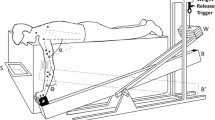Summary
The passive elastic torque function and the passive viscous torque function of the muscles and connective tissues spanning the elbow joint have been determined in three adult male subjects. The procedure for estimating the passive elastic torque involved measurement of the torque required to passively move the forearm-hand segment, at a constant angular velocity, throughout a complete range of elbow joint motion. The “suspension method” (Hatze, 1975) was used to obtain the estimate of passive viscous torque. Both of these torque functions were shown to be nonlinear functions of the angular displacement of the joint. In order to assess whether myotatic reflex activity was contributing to the damping of the segment, and thereby biasing the value of the torque contributed by passive viscous elements, the surface electromyograms of the biceps brachii and brachioradialis muscles were examined while the suspended body segment was oscillated. In one subject there was firm evidence of involuntary muscle activity in the brachioradialis muscle which tended to distort the oscillogram. This activity was enhanced when the subject maintained a voluntary isometric contraction in a remote muscle group (Jendrassik's manoeuvre). Based upon these observations, recommendations have been made for reducing unwanted myotatic reflex activity while using the “suspension method” to obtain estimates of various biomechanical parameters.
Similar content being viewed by others
References
Agarwal, G. C., Gottlieb, G. L.: The muscle silent period and reciprocal inhibition in man. J. Neurol. Neurosurg. Psychiat. 35, 72–76 (1972)
Boon, K. L., Hoff, A. L., Wallinga-de Jonge, W.: The mechanical behaviour of the passive arm. In: Biomechanics III (S. Cerquiglini, A. Venerando, J., Wartenweiler, eds.), pp. 243–248. Baltimore: University Park Press 1973
Gassel, M. M., Diamantopoulos, E.: The Jendrassik Maneuver II. An analysis of the mechanism. Neurology (Minneap.) 14, 640–642 (1964)
Hatze, H.: A new method for the simultaneous measurement of the moment of inertia, the damping coefficient and the location of the centre of mass of a body segment in situ. Europ. J. appl. Physiol. 34, 217–226 (1975)
Hatze, H.: The complete optimization of a human motion. Math. Biosci. 28, 99–135 (1976)
Hayes, K. C.: Jendrassik maneuver facilitation and fractionated patellar reflex times. J. appl. Physiol. 32, 290–295 (1972)
Hayes, K. C.: Tonic neck reflex influence on tendon and Hoffmann reflexes in man. EMG. Clin. Neurophysiol. 16, 251–261 (1976)
Hirt, S.: The tonic neck reflex mechanism in the normal human adult. Amer. J. phys. Med. 46, 362–369 (1967)
Jendrassik, E.: BeitrÄge zur Lehre von den Sehnenreflexen. Dtsch. Arch. klin. Med. 33, 177–199 (1883)
Marsden, C. D., Merton, P. A., Morton, H. B.: Changes in loop gain with force in the human muscle servo. J. Physiol. (Lond.) 222, 32P-34P (1972)
Nashold, B. S.: An electronic method for measuring and recording resistance to passive muscle stretch. J. Neurosurg. 24 (Suppl.), 310–314 (1966)
Otahal, S.: A method of measuring some kinetic properties of voluntary muscle activity. In: Biomechanics II (J. Vredenbrecht, J. Wartenweiler, eds.), pp. 181–184. New York: Karger 1971
Webster, D. D.: Rigidity in extrapyramidal disease. J. Neurosurg. 24 (Suppl.), 299–307 (1966)
Author information
Authors and Affiliations
Additional information
On leave from the National Research Institute for Mathematical Sciences, CSIR, Pretoria 0001
Rights and permissions
About this article
Cite this article
Hayes, K.C., Hatze, H. Passive visco-elastic properties of the structures spanning the human elbow joint. Europ. J. Appl. Physiol. 37, 265–274 (1977). https://doi.org/10.1007/BF00430956
Received:
Accepted:
Issue Date:
DOI: https://doi.org/10.1007/BF00430956




